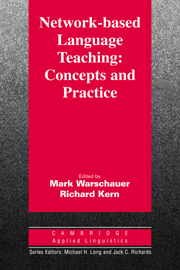Book contents
- Frontmatter
- Contents
- List of contributors
- Series editors' preface
- Preface
- 1 Introduction: Theory and practice of network-based language teaching
- 2 Sociocollaborative language learning in Bulgaria
- 3 On-line learning in second language classrooms: An ethnographic study
- 4 Negotiation in cyberspace: The role of chatting in the development of grammatical competence
- 5 Writing into change: Style shifting in asynchronous electronic discourse
- 6 Computers and collaborative writing in the foreign language curriculum
- 7 Networked multimedia environments for second language acquisition
- 8 An electronic literacy approach to network-based language teaching
- 9 Task-based language learning via audiovisual networks: The LEVERAGE project
- 10 Is networked-based learning CALL?
- Name index
- Subject index
10 - Is networked-based learning CALL?
Published online by Cambridge University Press: 05 October 2012
- Frontmatter
- Contents
- List of contributors
- Series editors' preface
- Preface
- 1 Introduction: Theory and practice of network-based language teaching
- 2 Sociocollaborative language learning in Bulgaria
- 3 On-line learning in second language classrooms: An ethnographic study
- 4 Negotiation in cyberspace: The role of chatting in the development of grammatical competence
- 5 Writing into change: Style shifting in asynchronous electronic discourse
- 6 Computers and collaborative writing in the foreign language curriculum
- 7 Networked multimedia environments for second language acquisition
- 8 An electronic literacy approach to network-based language teaching
- 9 Task-based language learning via audiovisual networks: The LEVERAGE project
- 10 Is networked-based learning CALL?
- Name index
- Subject index
Summary
In his overview, Levy defines computer-assisted language learning (CALL) broadly as “the search for and study of applications of the computer in language teaching and learning” (Levy, 1997a, p. 1). In Chapter 1 of this volume, Kern and Warschauer describe network-based language teaching (NBLT) as “language teaching that involves the use of computers connected to one another in either local or global networks.” On the basis of these broad definitions, it appears that network-based learning might be considered one type of CALL. Consistent with this expectation, the essays in this volume raise many of the same issues that have appeared in the CALL literature since the early 1980s issues such as evaluation and the role of the teacher.
Despite superficial appearances, however, one cannot be satisfied to consider NBLT the same as pre-network CALL simply because computers play a role in both types of activities. From the perspective of second language acquisition, it is significant that learners often interact with a computer program in pre-network CALL activities, but they usually interact with other people in NBLT activities. Drawing a sharp distinction between the “impoverished” interactions afforded by pre-network CALL and those of NBLT, Debski (1997b) points out that “until recently, very few teachers looked to the potential of computer technology to enrich the foreign language classroom through fostering human to human communication and creative endeavour” (p. 46). From a historical perspective, Kern and Warschauer (this volume) explain that theoretical foundations for network-based learning are social as well as cognitive in nature and that uses of computer-mediated communication have mainly focused on creating discourse communities.
- Type
- Chapter
- Information
- Network-Based Language Teaching: Concepts and PracticeConcepts and Practice, pp. 204 - 228Publisher: Cambridge University PressPrint publication year: 2000
- 12
- Cited by



